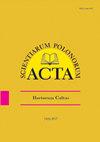Weed composition in conventionally and organically grown medical and aromatic plants
IF 0.7
4区 农林科学
Q4 HORTICULTURE
引用次数: 0
Abstract
This study aimed to compare weed flora in conventionally and organically grown medicinal and aromatic plants (MAPs): basil, pot marigold, dill, and peppermint; in terms of weed composition and weed abundance. A total of 28 weed species (25 and 15 species in conventional and organic crops, respectively) were identified.The presence and abundance of certain weed species were affected by MAP species and farming system. Higher weed diversity and weediness, and lower floristic similarity were found in conventionally grown crops. Also, the analysed MAPs differed in weediness by individual weed species. Correspondence analysis pointed to conventional and organic MAPs with the most frequent and most abundant weed species. Setaria pumila and Portulaca oleracea were the most frequent species in conventional; and Amaranthus retroflexus, Datura stramonium, and Sorghum halepense in organic crops. In both conventional and organic farming systems, therophytes were the most dominant life forms indicating a strong anthropogenic influence. The results should contribute to establishing weed control measures that are adequate for the two farming systems.常规和有机种植的药用和芳香植物中的杂草成分
本研究旨在比较传统和有机种植的药用和芳香植物(MAPs)中的杂草区系:罗勒、万寿菊、莳萝和薄荷;在杂草组成和杂草丰度方面。共鉴定出28种杂草(常规作物25种,有机作物15种)。某些杂草种类的存在和丰度受MAP种类和耕作制度的影响。常规种植作物的杂草多样性和杂草度较高,区系相似性较低。此外,所分析的map在单个杂草种类上存在差异。对应分析表明,常规地图和有机地图中杂草种类最多、最丰富。常规中最常见的种是羊尾草和马齿苋;有机作物中的逆行苋、曼陀罗和高粱。在传统和有机耕作系统中,植生植物是最主要的生命形式,表明强烈的人为影响。研究结果应该有助于建立适合两种耕作系统的杂草控制措施。
本文章由计算机程序翻译,如有差异,请以英文原文为准。
求助全文
约1分钟内获得全文
求助全文
来源期刊
CiteScore
1.30
自引率
14.30%
发文量
61
审稿时长
4-8 weeks
期刊介绍:
In Acta Scientiarum Polonorum Hortorum Cultus we publish original research papers and review articles containing new and significant information on broad aspects of horticulture and related disciplines. The papers are published in English only, in six issues yearly.

 求助内容:
求助内容: 应助结果提醒方式:
应助结果提醒方式:


